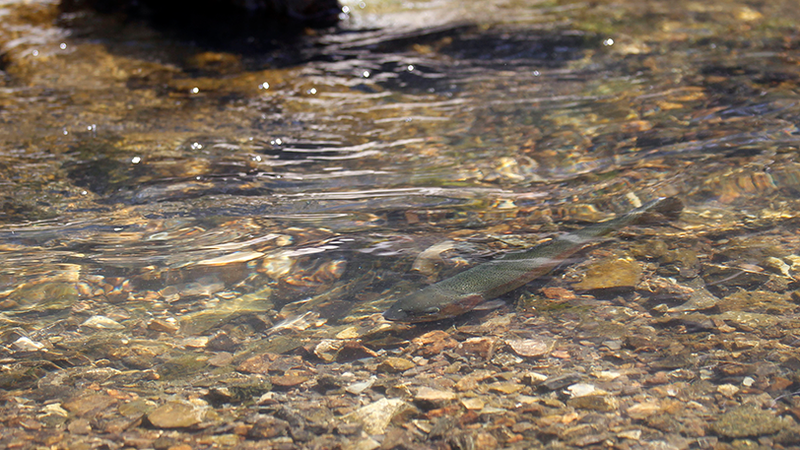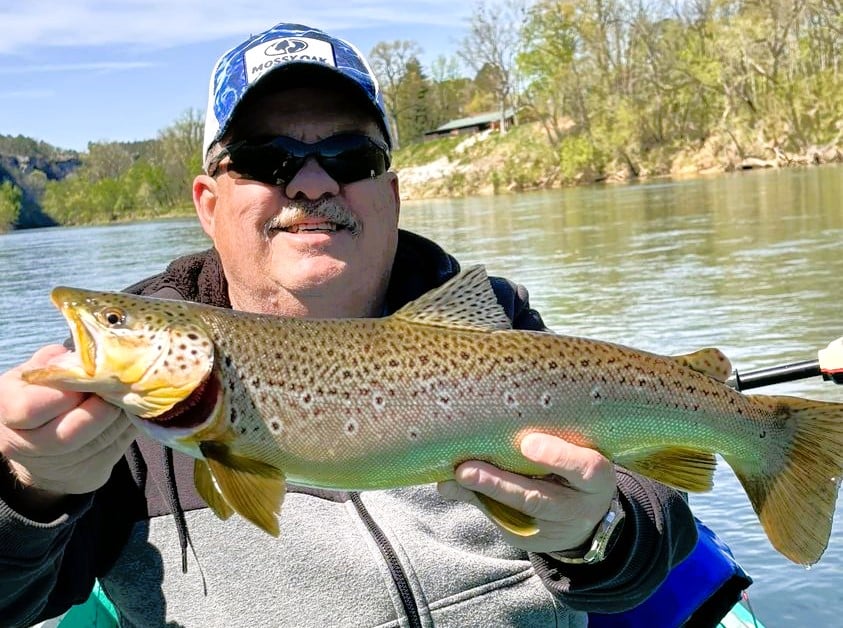Tiptoe through the trout streams during the fall spawn
ON 10-16-2019

Oct. 16, 2019
Randy Zellers
Assistant Chief of Communications
MOUNTAIN HOME — Native to Europe, the German brown trout found in the tailwaters of Beaver, Bull Shoals, Norfork and Greers Ferry dams, typically start their spawning run during fall and winter, offering die-hard anglers a chance at some fantastic fishing. But biologists ask anglers to keep a conservation mindset when chasing these gems of the tailwater so everyone will be able to enjoy them for years to come.
Chief among fishing faux pas with the wading community is the destruction of trout nests, called redds, which serve to keep the population going.
Christy Graham, trout program coordinator, says anglers should be aware of spawning activities and the damage caused when redds or spawning trout are disturbed.
“The AGFC Trout Management Program recommends anglers be mindful of spawning activity during this time of the year and to be careful when wade fishing to avoid trampling over redds,” Graham said. “Anglers should also be aware that there are some seasonal regulations in effect that coincide with the brown trout spawning season on both the White and Little Red Rivers.”
Trout are nest guarders, and they can be nest robbers. Removing a large brown trout from the redd it is guarding not only can cause harm to an already stressed fish, but enables predators, including other trout, to destroy the redd. Simply walking through a trout redd can have disastrous results, which is why the Bull Shoals Catch-and-Release Area along Bull Shoals White River State Park is closed to angling from Nov. 1 to Jan. 31 each year. An additional area becomes catch-and-release angling only during this time, to ensure spawning trout are not removed from the tailwater during the spawn.
According to Graham, trout redds can be identified fairly easily. They appear as clean, oval patches of small to medium-sized gravel and are typically 2 to 3 feet in diameter. The gravel in them is typically lighter-colored than surrounding gravel. There may be a small depression or mound, where gravel has been excavated and deposited over the eggs.
Fishing the trout spawn can produce some exciting action because extremely large brown trout tend to show themselves a bit more and become more aggressive during this time. But many dyed-in-the-wool trout anglers will avoid fishing for spawning fish entirely. Rainbow trout and cutthroats often produce some exceptional fishing on egg patterns and corn during this time because of their tendency to capitalize on brown trout eggs that become dislodged from nests and float downstream.
“If you do end up fishing around spawning areas for browns, there are a few things you can do to lessen the damage caused by angling during this time,” Graham said. “We always want anglers to use the best possible catch-and-release practices, but it’s even more critical during the spawn.”
Graham says aside from avoiding the spawning fish entirely, anglers can help provide next year’s fish by following a few simple steps. Avoid snagging fish, no matter how tempting it can be to “set the hook a little early.” Use barbless hooks to minimize damage to the fish’s mouth and land the fish as quickly as possible. Wet your hands to land the fish and minimize the amount of time it stays out of the water, so that it may return to its redd as soon as possible.
Visit www.agfc.com/trout for more information about trout fishing in Arkansas.
Recent News

Arkansas Wildlife Weekly Fishing Report
Apr. 18, 2024
Subscribe to Our Weekly Newsletter E-mails
Don’t miss another issue. Sign up now to receive the AGFC Wildlife Weekly Newsletter in your mailbox every Wednesday afternoon (Waterfowl Reports are published weekly during waterfowl season and periodically outside the season). Fishing Reports arrive on Thursdays. Fill in the following fields and hit submit. Thanks, and welcome!

